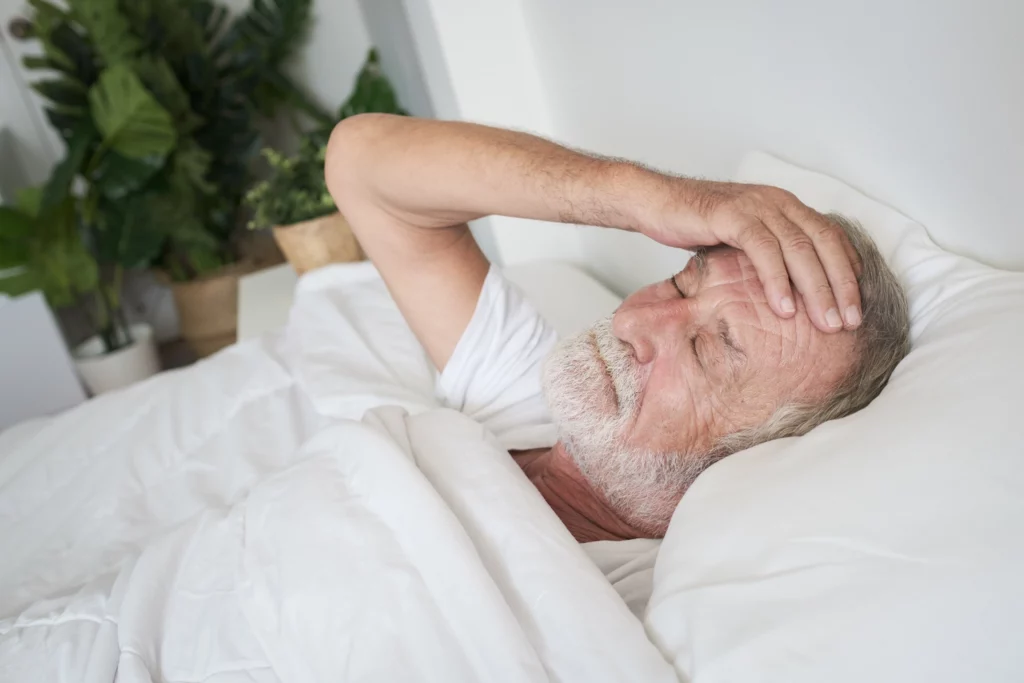
REM Sleep Behavior Disorder and the Link to Lewy Body Dementia
This post may contain affiliate links or Google Ads and we may earn a small commission when you click on the links at no additional cost to you. As an Amazon Affiliate, we earn from qualifying purchases. This is at no additional cost to you and helps with our website expenses.
REM sleep behavior disorder (RBD) is a condition in which people act out their dreams. The REM stands for rapid eye movement. The symptoms can include talking, walking, screaming, punching and kicking while in a deep sleep and acting out a dream. While it may seem like a harmless condition, it can often be a precursor to Lewy Body Dementia. In this blog post, we will discuss the link between REM sleep behavior disorder and Lewy Body Dementia. We will also look at how to deal with this condition if you or a loved one is diagnosed with it.
The REM Sleep Behavior Disorder and Lewy Body Dementia Link
REM sleep behavior disorder is often diagnosed in patients who have Lewy Body Dementia. This is because the symptoms of REM sleep behavior disorder often manifest years or even decades before any LBD symptoms arise. As such, it is important to be aware of the signs and symptoms of this condition so that you can get a diagnosis and treatment as soon as possible.
What is REM Sleep Behavior Disorder?

Normally, you don’t move during REM sleep, a common stage of sleep that recurs many times during the night. About 20% of your sleep is spent in REM sleep, the typical time for dreaming, which occurs primarily in the second half of the night.
The most common symptom of REM sleep behavior disorder is acting out one’s dreams. This can include talking, screaming, punching and kicking. While this may seem harmless at first, it can often lead to injuries if not properly controlled. It is important to seek medical help if you or your partner begins to exhibit these behaviors during sleep. A sleep study can diagnose REM sleep behavior disorder and help you get the treatment you need.
There are a few treatment options available for REM sleep behavior disorder. The most common is to use sleeping aids to help control the condition. If your partner has REM sleep behavior disorder, it is important to be careful when sleeping next to them. Some dreams can become quite violent and may result in injury if not properly controlled. As a caregiver, it is important to monitor sleep.
If you or someone you love has been diagnosed with REM sleep behavior disorder, it is important to seek medical help as soon as possible. With proper diagnosis and treatment, this condition can be managed and controlled.
What Causes it and who does it Affect?
During REM sleep, the body is temporarily paralyzed. This paralysis prevents acting out your dreams. With RBD, however, the nerve pathways that prevent muscles from moving do not work properly. As a result, the person with the disorder may kick, punch, or shout in their sleep. They may even get out of bed and walk around.
Fall Alert Bed Pad and Caregiver Pager
This 20in x 30in bed pad will alert when someone gets out of bed. It has a call button and a caregiver pager that will receive a signal when the alarm is activated by the person getting up. I’ve used this alert for when my husband gets up at night and it works quite well.
RBD can occur at any age, but it is most common in middle-aged and older adults. It affects men more often than women. RBD is more common in people with certain medical conditions, such as Parkinson’s Disease, Lewy Body Dementia, and Multiple System Atrophy. It is also more common in people who take certain medications, such as antipsychotics and antidepressants.
Real-Life Experiences of REM Sleep Behavior Disorder and Lewy Body Dementia
Decades before my husband was diagnosed with Lewy Body Dementia he had REM Sleep Behavior Disorder — but we didn’t know it had a name. He even told me about times when he was a kid and was sleepwalking. In all of our married life, he would talk in his sleep and sometimes act dreams out.
Many nights I would wake up in the middle of the night with him singing a song! A totally made-up song with hilarious lyrics. I always wanted to record it but in my half-asleep mode, I never got it together enough to use my phone to record it. Some nights I would laugh so hard it made my stomach hurt. When we went to the office the next day our secretary would love to hear the stories about his dreams and singing.
There are also nightmares. My husband is a Vietnam War combat Veteran. He was involved in and saw horrendous things. He has many nightmares about the war. He will scream and thrash like he is trying to kill someone or that someone is trying to kill him. I’ve had many nights woken up by these outbursts. I’ve even been the recipient of some flailing of his arms and kicking legs. Thank goodness he doesn’t usually remember these war nightmares.
The acting out of dreams has continued for years. About five years ago he was up in the middle of the night walking around and fell down the steps, 13 of them. He had broken ribs and a hematoma (blood on the brain). He spent several weeks in the hospital and a rehab center.
In the meantime, at a routine visit to his cardiologist, the doctor thought he had sleep apnea and suggested he have a sleep study done. After he had the sleep study the doctor there told me that he did not have sleep apnea but he did have REM Sleep Behavior Disorder. Then the words came out of her mouth. She said that it is often a precursor to Lewy Body Dementia. I had never heard of that and to be honest, I thought she was being ridiculous. Little did I know.
It was less than two years later that he was diagnosed with Lewy Body Dementia.
How is REM Sleep Behavior Disorder Diagnosed?
REM sleep behavior disorder can be diagnosed by a sleep specialist. To diagnose the disorder, the specialist will ask about your medical history and symptoms. They may also recommend that you have a sleep study. During a sleep study, you will be monitored overnight to see if you have any abnormal behaviors during sleep.
How is a Sleep Study done?
A sleep study is a non-invasive test used to diagnose sleep disorders. During the study, patients are monitored overnight in a sleep lab while they sleep. The data collected during the sleep study is then used to determine if the patient has a sleep disorder and, if so, to develop a treatment plan. Sleep studies are usually performed on an outpatient basis, which means that patients can go home after the study is completed.
A sleep study, also called a polysomnogram, is a test used to diagnose sleep disorders. The sleep study is performed overnight in a sleep lab or hospital. It is performed in a room much like a hotel room. It records various electrical activities from your brain, heart, muscles, and more.
An EEG sensor is typically used to measure brain activity, while an EOG sensor is used to measure eye movements. The sensors are usually attached to the head using adhesive and they are connected to a computer via wires. The computer records the data from the sensors and produces a study report.
There are usually cameras in the room so the technician can monitor any movement during the sleeping period. The technician is generally in a room right next to the room the patient is in.
The sleep study can help doctors identify sleep problems such as sleep apnea, insomnia, and restless legs syndrome.
Medications that can Help
Melatonin
Treatment for RBD usually involves melatonin, a hormone that helps regulate the sleep-wake cycle. Melatonin is a hormone that is naturally produced in the body. It helps to regulate sleep and wake cycles. Melatonin supplements are available over the counter and can be taken before bedtime.
Melatonin supplements may help to improve sleep onset and sleep quality in people with RBD. The recommended dose of melatonin for RBD is 3-6 mg taken before bedtime. Some people may experience side effects such as headache, nausea, or daytime drowsiness when taking melatonin. It is important to talk to your doctor about the risks and benefits of melatonin before starting any supplement regimen.
Clonazepam for REM Sleep Behavior Disorder
Clonazepam is a medication that is used to treat various conditions, including seizures, anxiety, and panic disorders. It is also sometimes used off-label to treat REM sleep behavior disorder (RBD). RBD is a condition characterized by disruptive behaviors during sleep, such as thrashing or kicking. Clonazepam works by depressing the central nervous system, which helps to reduce the frequency and severity of RBD episodes.
Clonazepam is generally well-tolerated, but side effects may include dizziness, drowsiness, and decreased coordination. Clonazepam should not be taken with alcohol or other central nervous system depressants. If you are considering Clonazepam for the treatment of RBD, talk to your doctor to see if it is right for you.
Conclusion
REM sleep behavior disorder is a serious condition that can be a precursor to Lewy Body Dementia. If you or someone you love has been diagnosed with REM sleep behavior disorder, it is important to seek treatment right away. There are many resources available to help you deal with this condition. With proper treatment, you can minimize the symptoms and improve your quality of life.
Do you have REM sleep behavior disorder? Do you know someone who does and also has Lewy Body Dementia? Let us know in the comment section below.





